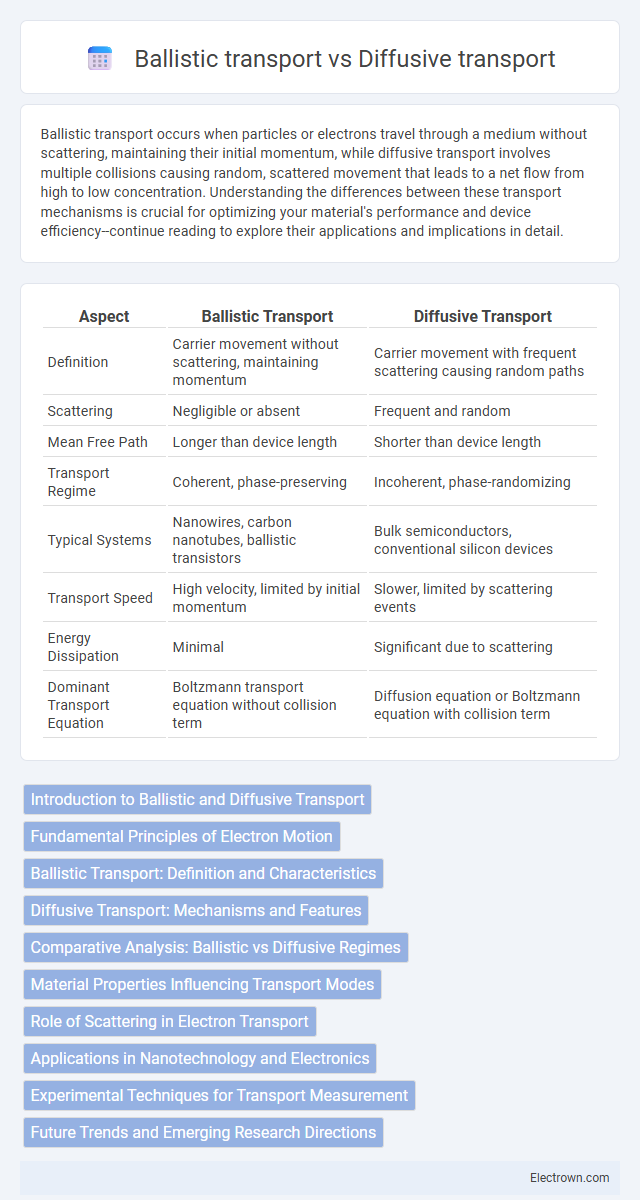Ballistic transport occurs when particles or electrons travel through a medium without scattering, maintaining their initial momentum, while diffusive transport involves multiple collisions causing random, scattered movement that leads to a net flow from high to low concentration. Understanding the differences between these transport mechanisms is crucial for optimizing your material's performance and device efficiency--continue reading to explore their applications and implications in detail.
Table of Comparison
| Aspect | Ballistic Transport | Diffusive Transport |
|---|---|---|
| Definition | Carrier movement without scattering, maintaining momentum | Carrier movement with frequent scattering causing random paths |
| Scattering | Negligible or absent | Frequent and random |
| Mean Free Path | Longer than device length | Shorter than device length |
| Transport Regime | Coherent, phase-preserving | Incoherent, phase-randomizing |
| Typical Systems | Nanowires, carbon nanotubes, ballistic transistors | Bulk semiconductors, conventional silicon devices |
| Transport Speed | High velocity, limited by initial momentum | Slower, limited by scattering events |
| Energy Dissipation | Minimal | Significant due to scattering |
| Dominant Transport Equation | Boltzmann transport equation without collision term | Diffusion equation or Boltzmann equation with collision term |
Introduction to Ballistic and Diffusive Transport
Ballistic transport occurs when electrons or particles move through a medium without scattering, allowing them to maintain their energy and momentum over short distances at the nanoscale. Diffusive transport, in contrast, involves multiple scattering events causing a random walk-like movement, resulting in energy dissipation and resistance increase. Understanding these mechanisms is crucial for optimizing the performance of nanoscale electronic devices and improving your material design strategies.
Fundamental Principles of Electron Motion
Ballistic transport occurs when electrons move through a material without scattering, maintaining their momentum over distances comparable to the device size, enabling ultra-fast and energy-efficient conduction. Diffusive transport involves frequent electron collisions with impurities, phonons, or defects, resulting in random scattering and a slower, resistive flow determined by classical diffusion equations. Understanding the fundamental principles of electron motion in these regimes is crucial for optimizing Your semiconductor devices and nanoscale electronic applications.
Ballistic Transport: Definition and Characteristics
Ballistic transport occurs when electrons or charge carriers move through a medium without scattering or collisions, maintaining their initial momentum over short distances typically in nanoscale materials. This transport regime is characterized by high carrier mobility and minimal resistance, enabling faster signal propagation in semiconductor devices and nanowires. Your understanding of ballistic transport is crucial for designing high-speed electronics and quantum devices where preserving electron coherence is essential.
Diffusive Transport: Mechanisms and Features
Diffusive transport occurs when particles such as electrons or molecules move randomly due to collisions and scattering events, leading to a net flow from high to low concentration regions. This mechanism is governed by Fick's laws and is characterized by a gradual, non-directional movement that depends on material properties like diffusivity and temperature. Your understanding of diffusive transport highlights its significance in semiconductor devices, where it contrasts sharply with ballistic transport by exhibiting frequent scattering and energy dissipation.
Comparative Analysis: Ballistic vs Diffusive Regimes
Ballistic transport occurs when electrons travel through a material without scattering, maintaining their momentum over distances comparable to the device length, typically observed in nanoscale conductors like carbon nanotubes and graphene. Diffusive transport dominates in larger-scale systems where frequent scattering events cause electrons to follow random paths, characterized by Ohm's law and described by diffusion equations. The transition between ballistic and diffusive regimes depends on the mean free path relative to the device dimensions, influencing electrical conductivity and thermal transport properties in semiconductors and metals.
Material Properties Influencing Transport Modes
Material properties such as mean free path, carrier mobility, and impurity concentration critically influence ballistic and diffusive transport modes in semiconductors. High-quality materials with long mean free paths enable ballistic transport by allowing carriers to travel without scattering, while increased impurity levels and lattice vibrations promote diffusive transport due to frequent collisions. Understanding these properties helps optimize Your device performance by selecting materials suited for the desired transport mechanism.
Role of Scattering in Electron Transport
Ballistic transport occurs when electrons move through a material without scattering, maintaining their initial momentum and energy, which enables high-speed conduction over short distances. In contrast, diffusive transport is dominated by frequent scattering events from impurities, phonons, or defects, causing electrons to undergo random trajectories and resulting in resistance. The scattering mechanisms critically influence electron mobility, with reduced scattering enhancing ballistic transport and increased scattering leading to diffusive behavior.
Applications in Nanotechnology and Electronics
Ballistic transport enables ultra-fast electron movement with minimal scattering, crucial in nanoscale transistors and quantum devices for enhanced performance and energy efficiency. Diffusive transport, characterized by frequent electron scattering, dominates in larger-scale electronic components, influencing heat dissipation and reliability in conventional semiconductor devices. Nanotechnology leverages ballistic transport for developing next-generation sensors, nano-electromechanical systems (NEMS), and high-frequency transistors, pushing the limits of miniaturization and speed.
Experimental Techniques for Transport Measurement
Experimental techniques for ballistic transport primarily include low-temperature scanning tunneling microscopy (STM) and conductance quantization measurements in quantum point contacts, which capture electron flow without scattering. Diffusive transport is investigated using methods such as four-point probe measurements and Hall effect experiments, which assess resistivity and carrier mobility influenced by scattering events. Understanding your sample's transport regime requires selecting appropriate measurement techniques tailored to distinguishing between these fundamentally different conduction mechanisms.
Future Trends and Emerging Research Directions
Future trends in ballistic transport research emphasize the development of ultra-fast, low-energy nanoelectronic devices leveraging quantum coherence in materials like graphene and topological insulators. Emerging research explores hybrid systems combining ballistic channels with diffusive elements to optimize performance in quantum computing and advanced sensing applications. Your ability to harness these phenomena could revolutionize electronics by minimizing energy loss and maximizing signal integrity at nanoscales.
Ballistic transport vs Diffusive transport Infographic

 electrown.com
electrown.com